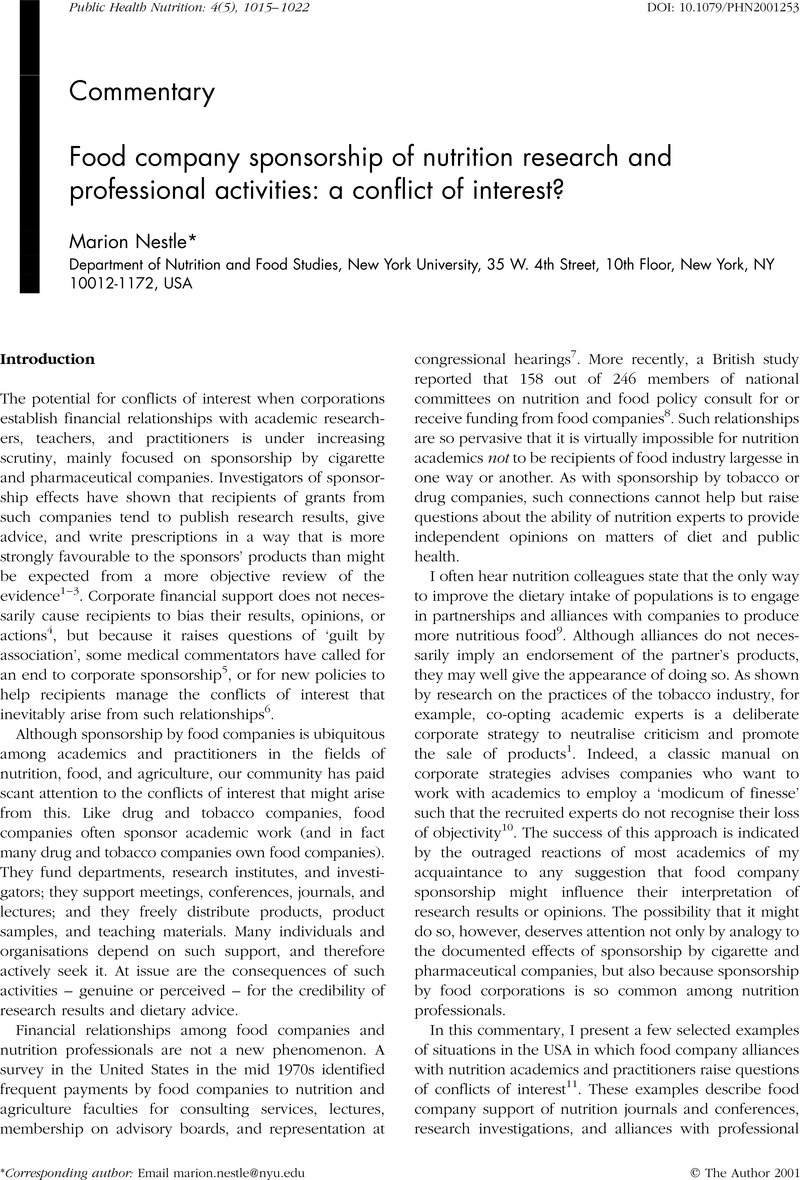Crossref Citations
This article has been cited by the following publications. This list is generated based on data provided by Crossref.
Margetts, Barrie
and
Arab, Lenore
2001.
Sponsorship of research in Public Health Nutrition.
Public Health Nutrition,
Vol. 4,
Issue. 5,
p.
933.
Vorster, Hester
2001.
Sponsorship of nutrition research in developing countries.
Public Health Nutrition,
Vol. 4,
Issue. 5,
p.
1023.
Ebbeling, Cara B
Pawlak, Dorota B
and
Ludwig, David S
2002.
Childhood obesity: public-health crisis, common sense cure.
The Lancet,
Vol. 360,
Issue. 9331,
p.
473.
Bloomgarden, Zachary T.
2003.
Prevention of Obesity and Diabetes.
Diabetes Care,
Vol. 26,
Issue. 11,
p.
3172.
Hughes, Roger
2004.
Editorial.
Public Health Nutrition,
Vol. 7,
Issue. 5,
p.
585.
Hughes, Roger
2006.
A Socioecological Analysis of the Determinants of National Public Health Nutrition Work Force Capacity.
Family & Community Health,
Vol. 29,
Issue. 1,
p.
55.
Woteki, Catherine E.
2006.
Ethics Opinion: Conflicts of Interest in Presentations and Publications and Dietetics Research.
Journal of the American Dietetic Association,
Vol. 106,
Issue. 1,
p.
27.
Fox, Ann
2008.
Re: Out of the Box ‘What’s Wrong with Industry?’.
Public Health Nutrition,
Vol. 11,
Issue. 3,
p.
326.
McComas, Katherine A.
2008.
Session 5: Nutrition communication The role of trust in health communication and the effect of conflicts of interest among scientists.
Proceedings of the Nutrition Society,
Vol. 67,
Issue. 4,
p.
428.
Thomas, O
Thabane, L
Douketis, J
Chu, R
Westfall, A O
and
Allison, D B
2008.
Industry funding and the reporting quality of large long-term weight loss trials.
International Journal of Obesity,
Vol. 32,
Issue. 10,
p.
1531.
Loss, J.
Böhme, M.
and
Nagel, E.
2009.
Finanzierung von Gesundheitsförderung auf kommunaler Ebene.
Prävention und Gesundheitsförderung,
Vol. 4,
Issue. 3,
p.
195.
BROWNELL, KELLY D.
and
WARNER, KENNETH E.
2009.
The Perils of Ignoring History: Big Tobacco Played Dirty and Millions Died. How Similar Is Big Food?.
The Milbank Quarterly,
Vol. 87,
Issue. 1,
p.
259.
Nkansah, Nancy
Nguyen, Thao
Iraninezhad, Hoda
and
Bero, Lisa
2009.
Randomized trials assessing calcium supplementation in healthy children: relationship between industry sponsorship and study outcomes.
Public Health Nutrition,
Vol. 12,
Issue. 10,
p.
1931.
Folker, Anna Paldam
Holm, Lotte
and
Sandøe, Peter
2009.
‘We Have to Go Where the Money Is’—Dilemmas in the Role of Nutrition Scientists: An Interview Study.
Minerva,
Vol. 47,
Issue. 2,
p.
217.
Gillies, Peter J.
and
Kris-Etherton, Penny M.
2010.
Opportunities and Challenges in Nutrigenetics/Nutrigenomics: Building Industry-Academia Partnerships.
Journal of Nutrigenetics and Nutrigenomics,
Vol. 3,
Issue. 4-6,
p.
296.
Schinca, N.
and
Russolillo, G.
2011.
Revista Española de Nutrición Humana y Dietética, la renovada revista de la Asociación Española de Dietistas-Nutricionistas.
Revista Española de Nutrición Humana y Dietética,
Vol. 15,
Issue. 1,
p.
1.
Jenkin, G. L.
Signal, L.
and
Thomson, G.
2011.
Framing obesity: the framing contest between industry and public health at the New Zealand inquiry into obesity.
Obesity Reviews,
Vol. 12,
Issue. 12,
p.
1022.
Goldberg, Jeanne P.
and
Sliwa, Sarah A.
2011.
Communicating actionable nutrition messages: challenges and opportunities.
Proceedings of the Nutrition Society,
Vol. 70,
Issue. 1,
p.
26.
Diels, Johan
Cunha, Mario
Manaia, Célia
Sabugosa-Madeira, Bernardo
and
Silva, Margarida
2011.
Association of financial or professional conflict of interest to research outcomes on health risks or nutritional assessment studies of genetically modified products.
Food Policy,
Vol. 36,
Issue. 2,
p.
197.
Schleifer, David
2011.
We Spent a Million Bucks and Then We Had To Do Something.
Bulletin of Science, Technology & Society,
Vol. 31,
Issue. 6,
p.
460.



